#India's first lithium-ion battery factory
Explore tagged Tumblr posts
Text
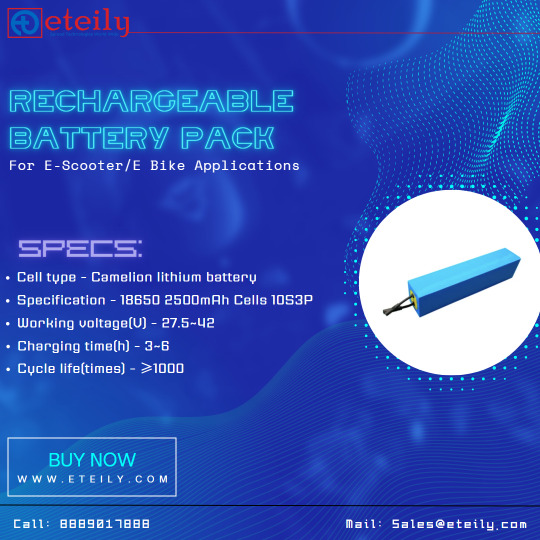
#Battery Manufacturers in India#Best Battery Sector Stocks in India#Indian battery maker#Top EV Battery Manufacturers in India#best battery suppliers in India.#lithium-ion battery manufacturers in India#leading battery manufacturers in India.#supply high-quality automotive battery#largest Battery Manufacturer In India#India's first lithium-ion battery factory#India's largest automotive batteries manufacturer#Indian battery manufacturing ecosystem.#The largest battery producer in India#Features of Lithium Batteries#electrical equipment manufacturing#Lithium Ion Battery Manufacturers Stocks In India#best manufacturer and supplier of li ion battery#Lithium Battery Manufacturer in India#TDS Lithium-Ion Battery#Lithium-ion Battery Manufacturers In India#Lithium-ion battery manufacturers and assemblers in India#TDS lithium Battery#lithium-ion battery manufacturers in india for electric vehicles#top ev battery manufacturers in india#lithium-ion battery rechargeable#list of electric vehicle battery manufacturers in india listed#in nse#12v 150ah lithium ion battery price in india#24v lithium ion battery for solar
0 notes
Text
Tata Group's Visionary Semiconductor Venture in Dholera
In a significant stride towards technological progress and industrial expansion, Tata Group, under the guidance of Chairman N Chandrasekaran, has announced ambitious plans to establish a cutting-edge semiconductor fabrication plant in Dholera, Gujarat. This transformative initiative, slated to begin operations in 2024, was officially revealed during the 10th Vibrant Gujarat Global Summit, marking a momentous juncture for both Tata Group and Gujarat's technological landscape.
Tata's Strategic Vision for Semiconductor Manufacturing in Gujarat
The semiconductor manufacturing sector plays a pivotal role in a nation's technological foundation, and Tata Group's entry into this field signifies a revolutionary shift in India's capabilities within the electronics and technology sector. The selection of Dholera as the site for the semiconductor plant reflects Tata Group's commitment to fostering innovation and positioning India as a global technology hub.
Comprehensive Expansion: Beyond Semiconductors
Chairman Chandrasekaran's announcement expands beyond the semiconductor project, shedding light on Tata Group's multifaceted expansion plans in Gujarat. The conglomerate is gearing up for the construction of a 20-gigawatt lithium-ion storage battery factory in Sanand, Gujarat, within the next two months. This strategic move is in response to the growing demand for electric vehicles (EVs) and underscores Tata Group's commitment to sustainable technologies.
Sanand is emerging as a focal point for Tata Group's ventures into the electric vehicle sector, poised to play a pivotal role in meeting the escalating demand for EVs in India. This aligns seamlessly with the global trend towards environmentally conscious modes of transportation.
Strategic Diversification: Defense Initiatives
Tata Group's presence in Gujarat goes beyond semiconductors and electric vehicles. The conglomerate is actively involved in constructing the C295 defense aircraft in Vadodara, with plans to extend its manufacturing operations to Dholera. This diversification into the defense sector underscores Tata Group's commitment to national security and aligns harmoniously with the government's "Make in India" initiative.
Chairman Chandrasekaran also alluded to the upcoming launch of the first phase of the Indian Institute of Skills in Gujarat by March 2024. This collaborative initiative with central and state governments underscores Tata Group's dedication to skill development and education, contributing significantly to the socio-economic development of the region.
Gujarat's Integral Role in Tata Group's Growth Narrative
Chairman N Chandrasekaran highlighted Tata Group's deep-rooted connection with Gujarat, attributing it to the founder's hometown being Navsari. Currently operating 21 companies in the state, Tata Group has become a major contributor to Gujarat's economic landscape, providing employment opportunities for over 50,000 people.
Commending the visionary leadership of Prime Minister Narendra Modi, Chairman Chandrasekaran acknowledged the substantial progress made by Gujarat under his guidance. The Vibrant Gujarat Global Summit, initiated by Prime Minister Modi two decades ago, has played a pivotal role in attracting investments and fostering economic development in the state.
Key Highlights: Tata Semiconductor Manufacturing Company
As part of Tata Group's foray into semiconductor manufacturing, the company is poised to establish the Tata Semiconductor Manufacturing Company in Dholera, Gujarat. This move is set to redefine India's capabilities in semiconductor technology.
Strategic Location: Dholera was chosen strategically for the semiconductor plant, aligning with Tata Group's vision for Gujarat as a hub for technological innovation and business growth.
Operational Commencement: The semiconductor plant is on track to commence operations in 2024, signifying Tata Group's swift contribution to India's semiconductor landscape.
Diversified Expansion: Beyond semiconductors, Tata Group's expansion includes a lithium-ion storage battery factory in Sanand, addressing the increasing demand for electric vehicles and positioning Tata Group as a key player in sustainable technology.
Defense Initiatives: Tata Group's involvement in the construction of the C295 defense aircraft underscores its commitment to national security and defense manufacturing.
Skill Development: The launch of the Indian Institute of Skills reflects Tata Group's dedication to skill development and education, contributing to the overall socio-economic development of the region.
Tata Semiconductor Manufacturing Company: Paving the Way Forward
The establishment of Tata Semiconductor Manufacturing Company in Dholera is indicative of Tata Group's forward-looking approach. As India strives to strengthen its position in the global semiconductor market, Tata Group's entry into this sector is poised to usher in transformative changes in the country's technological landscape.
Market Impact: Tata Group's venture into semiconductor manufacturing is expected to significantly impact the Indian electronics market, reducing dependency on imports and contributing to India's self-reliance in the electronics sector.
Technological Innovation: The semiconductor plant in Dholera is not just a response to domestic demand but also a hub for technological innovation, enabling India to compete globally in cutting-edge technology.
Job Creation and Economic Growth: The establishment of the semiconductor plant will create numerous job opportunities, directly and indirectly, contributing to the economic growth of the region and the nation.
Strategic Partnerships: Tata Group's foray into semiconductor manufacturing may pave the way for strategic partnerships with global technology companies, fostering collaborations that could lead to the transfer of advanced technological know-how and expertise.
Conclusion: Pioneering Tomorrow's Technology
Tata Group's announcement of the semiconductor plant in Dholera is not just a business decision but a strategic move that aligns with the larger goals of India's economic and technological development. This venture, coupled with the broader expansion plans in Gujarat, solidifies Tata Group's position as a catalyst for change and progress in India's industrial landscape. As the semiconductor plant takes shape, it symbolizes not only the technological capabilities of Tata Group but also the aspirations of a nation poised for a technological leap into the future.
0 notes
Text
Ola S1X Electric Scooter production model Revealed
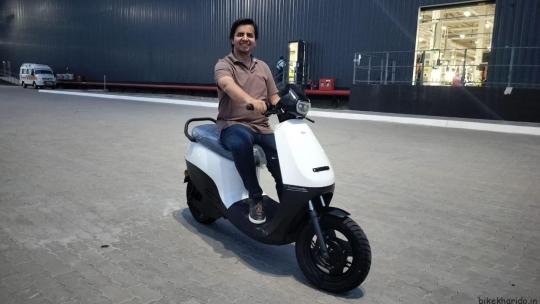
Ola S1X Electrical Scooter
Ola is all set to launch a brand new S1X electric scooter.
Ola Electric was one of many first manufacturers to launch electric scooters in India. Nevertheless, it has gone by many ups and downs lately. Just lately, the Bengaluru-based firm launched the Ola S1X.
It was touted as an affordable electric scooter for the Indian prospects. Now, the company’s founder and CEO, Bhavish Aggarwal has shared pictures of the first-ever S1X scooter on his X (formerly Twitter) account.
These photos were taken in entrance of the Ola Future Factory.
You may like it : Which is the No 1 bike?
Bhavish Aggarwal Reveals Ola S1X
As you can see within the above images, Bhavish Aggarwal is sitting on an Ola S1X electric scooter with a White color finish. One other picture contains staff members as nicely.
The caption reads, “The first S1X off the line!! I feel I like this design probably the most amongst all our S1 products.” The Ola S1X is available in three variants. Whereas the bottom model (with 2 kWh battery) is priced at Rs 89,999, the 3 kWh battery S1X mannequin prices Rs 99,999.
However, the Ola S1X+ model comes at Rs 1,09,999. The three versions had been launched with an introductory price of Rs 79,999, Rs 89,999, and Rs 99,999, respectively.
You may like it : Kawasaki ZX-4R Launched For Rs. 8.49 Lakh
When it comes to design, the Ola S1X features a single-piece seat design and a curvy body. You too can see steel wheels, a big headlight cowl, and twin projector headlamps with LED DRL.
On the entrance, the electric scooter will get twin fork suspension. The company has added twin shock absorbers within the rear. While the bottom variant weighs 101 kg, the three kWH model weighs 108 kg. Each variants include a 3.5-inch LCD display and a physical key.
You may like it : Second Hand Bikes
Ola S1X Specs
The 2 kWh battery mannequin is backed by a 2 kWh Lithium-ion battery. It’s paired with a 2.7 kW motor that provides a top speed of 85 kmph and a most true range of 85 km (in Eco mode).
This model ships with a 350W charger. It’s to be famous that this variant lacks options like music controls, navigation, call/ SMS alerts, keyless operation, and OTA updates.
However, the three kWh battery variant is paired with a 2.7 kW motor. It comes with a high speed of 90 mph and affords a real range of 125 km (in Eco mode).
The highest-spec Ola S1+ variant can also be backed by a 3 kWh battery and a 2.7 kW motor that provides a high pace of 90 kmph and a variety of 125 km.
Nevertheless, this variant will get features like cruise control, music control, Bluetooth/GPS connectivity, turn-by-turn navigation, distant boot lock/unlock, predictive upkeep, and Ola app control.
The company will even offer OTA updates for this model.
You may like it : New KTM Duke 390 Launch Price Rs 3.1 L
0 notes
Text
"Now we are all sons of bitches."
(Kenneth Bainbridge, 1945)
This is going to be a dark post.
This has been sitting in my backlog for about five years or so, I considered dumping it on the grounds that the situation should be obvious by now, but I’m still seeing news articles which hint that people haven’t quite got it, and once the current crisis subsides, it will be forgotten again.
First of all, let's talk about life in The West in general, and the UK in particular.
We don't like pollution, we don't like low pay, we don't like the idea that anyone should be without a DVD player, we don't like messy jobs, and at heart, we just don't like paying for things.
So we've banned them (After protests, riots and some really strongly worded petitions.) , well, more or less.
Now let's talk about some uncomfortable truths.
Reality demands that for something to exist it must be made, and that making it will require a certain amount of energy, material and labour, and that it will produce a certain amount of waste.
Everything has to be made by someone, somewhere, it's easier to pay them little if they're desperate and you don't need to share air with them.
Manufacturing a ton of... say... plastics, or lithium ion batteries will generate a certain mass of byproduct, as will the soldering process for a square meter of PCB, these byproducts can either be contained and processed (expensive) or become pollutants (cheap.)
Factories need energy to run, it's either from expensive, cleaner, plants, or it's from cheap plants that would have left Brunel wondering why we hadn't moved on from the 1800s.
Now some would say that this is short sighted, we've banned all the ways of making these things cheaply, and our quality of life and political situation would crumble overnight without them, but the good news is... we can offset it, just like we offset our carbon.
People in the far east can have a miserable life, so that we don't have to.
We've been through similar phases more than once in the last few hundred years. Although I was alive in the eighties I didn't have anything to compare them to until much later;
Recently, while I was watching "Alien" one of my housemates observed that it looked very much like a film of the 80s. The penny dropped for me, that the silicon revolution had been in the 70s, and the 80s simply saw things made 90% cheaper and productionised into people's homes, enabled by cheap manufacturing in Japan and Hong Kong
Before that we imported manpower from Jamaica, go back much further, and the only word I can bring myself to type is “Plantation”.
In 1984 a VHS player was a luxury item, weeks or even months of salary, and many people got by without. Buying a DVD player for £20, or an MP3 player for £5 is not some achievement for equality in the UK, instead it's a chance to pass the pain on, the differential between rich (As defined by, say, assets of a few million pounds, trappings such as routinely new cars and public school education.) and poor (As defined by living in social housing.) Is embarrassingly slim when compared to those excluded by benefits, or as my rant is going, excluded from the west.
I would hope that the celebrated social reformers across the ages would not be pleased by this "progress" but horrified that our progress has been to find someone else to victimise, someone out of sight, someone who we can pretend doesn't exist, someone, who may as well not be human. What we see is "better" therefore we can be pleased, it's simplistic, it's childish, we stamp our feet and sulk, and write petitions until we're told that it doesn't matter any more.
A particularly graphic example was the "Ghost Fleet", a fleet of World-War-II destroyers was brought across the ocean to be scrapped on The Tyne, the facilities could easily deal with the pollutants, the vessels would be re-cycled, and the workers well paid.
One whiff of this dirty kind of work and Greenpeace swung in to action, cheering their victory as the fleet went elsewhere to be broken up. Jobs were lost at the UK shipyards, and it’s probably best not to speculate on what was lost where the ships were eventually beached in India: The local court system had a decades long backlog of workplace manslaughter cases, and the workers probably didn’t get protection gear.
This wasn't concern for the global ecosystem, it was glorified NIMBYism.
At heart, give them a few superficial victories and they really don't give a flying fuck about the larger environment.
Infact the cult of material consumption in the west, so pervasive that we feel it our birthright, is driven by our maneauvering to avoid any meaningful payment for it, financial or environmental.
And now back to 2020.
When talking about astronomy I like to say that “anything more than a few dozen lights years away, is just a pretty picture”: absent Warp Drive being invented and becoming a consumer technology in your lifetime, nothing that happens further away than that can meaningfully effect you. This combines with an observation a friend of mine made about Extinction Rebellion, “Do whatever you like to save the environment, but you can’t turn off transatlantic air travel”
(Of course, courtesy of Covid-19, not only has that happened, but fleets of 747s are being decommissioned.)
The principal is the same, without air travel the wonders of the world, and friends that have moved to other countries, suddenly just become pictures rather than things that you might experience again.
My retort to my friend was “What about turning off cheap goods from China”? Suddenly we have the prospect of 1970s living, where thrift stores are utterly essential.
The follow through of the £20 DVD player is that it’s too cheap to repair. While back in the 80s any town of more than a few thousand people had a TV repair shop, repairs of consumer goods are spotty. In the UK the best you can hope for is module level replacement, such as a new screen or battery for a mobile phone, and tons of theoretically repairable hardware reaches landfill or recycling grinders every day.
When I originally wrote this I veered in to memetic pollution: that’s a topic for another rant.
1 note
·
View note
Text
IESA to launch India Battery Supply Chain Council; aims to develop complete supply chain ecosystem for batteries
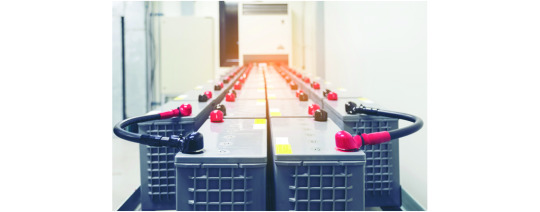
With the view to developing a holistic ecosystem for the supply chain of batteries, the India Energy Storage Alliance (IESA) India’s leading industry alliance on energy storage, e-mobility and microgrids have announced that it will launch the India Battery Supply Chain Council (IBSCC) on Thursday, December 9 in Delhi.
IBSCC will serve as a common platform for all relevant stakeholders to work on the complete development of the battery supply chain needed to support upcoming gigafactories in India.
“Apart from setting up 4-5 gigafactories under the ACC PLI,” explained Dr. Rahul Walawalkar, President, IESA. “We need to develop a complete supply chain for availing raw materials needed for these gigafactories so that we are not replacing one co-dependency with other.”
IESA organized IBSCC’s first stakeholder’s meet on Thursday, December 2, outlining its goals, vision, and plan of action for the months ahead.
“What we hope to do through IBSCC is to identify issues, faced by member companies or industry collectively [related to raw materials, material supply or R&D], establish a consortium, so we have a better chance of not just meeting requirements of the Indian gigafactories, but can also become a supplier for global giga factories being set up in Europe and Americas in the coming decade,” said Dr. Walawalkar.
The Production-Linked Incentive (PLI) scheme envisages setting up a cumulative manufacturing capacity of 50 GWh for Advanced Chemistry Cell (ACC) and an additional cumulative capacity of 5 GWh for niche ACC technologies. Beyond the ACC PLI target of 50 GWh of cell manufacturing capacity and supporting the chemical processing industry to get developed by 2027, IESA expects 100+ GWh manufacturing capacity to be built in India by 2030 and 500+ GWh of manufacturing capacity by 2035.
At the first stakeholder's meet, it was announced that V.K. Soni, Head of Projects, Gujarat Fluorochemicals Ltd will Chair the newly formed IBSCC, and Vikram Handa, MD, Epsilon Carbon Ltd will serve as its co-chair.
Production Linked Incentives (PLI) schemes for automobile, auto components, and advanced chemistry cell battery storage manufacturing will provide impetus to the domestic manufacturing ecosystem involved in manufacturing EVs and lithium-ion batteries (LiB), noted V. K. Soni, IBSCC Chair.
However, he cautioned, that faster implementation along with the creation of indigenous capacities of key components [required in making LiBs] were important factors for the success of the schemes.
IBSCC currently includes 10+ core companies, namely, BASF, Epsilon Advanced Materials Pvt Ltd, Himadri Speciality Chemical Ltd., Atotech Group, Applied Materials, MacDermid Alpha Electronics Solutions, Lucas TVS, 24M Technologies, Fortum Recycling & Waste, Neogen Chemicals Limited, Bry-Air (Asia) Private Limited, Bry-Air Inc., Ador Digatron Pvt. Ltd, Keysight Technologies, Gujarat Fluorochemicals Limited, Schaltbau India, Manikaran Group, SUEZ - Water Technologies & Solutions, and Customized Energy Solutions.
Commenting on the India scenario, Vikram Handa, MD, Epsilon Carbon, and co-chair of IBSCC said, “there is a huge opportunity for India to develop this [battery] industry not only to cater to domestic demand but also the international demand.”
Mr. Handa lauded IESA’s new initiative, acknowledging the long-time need for working together with a focused group to address key challenges facing the battery manufacturing sector.
India Battery Manufacturing & Supply Chain summit
IESA has organized the “India Battery Manufacturing & Supply Chain Summit” on December 9 in Delhi where IBSCC will be launched and further deliberation on the topic will continue to build momentum.
The summit is all set to host eminent industry leaders, think tanks, scholars, and policymakers including S Amit Mehta, Joint Secretary, Department of Heavy Industries (DHI); Sudhendu Sinha, Advisor, Infrastructure Connectivity & Electric Mobility, NITI Aayog; Satendra Singh, Joint Secretary, Ministry of Mines; Tim White, Counsellor Commercial, Trade and Investment Commissioner, Australian High Commission, New Delhi; Randheer Singh, Sr. Specialist & Director, NITI Aayog; Dr. Sankha dip Das, Scientist D, Ministry of Electronics and Information Technology (MEITY) among others.
Apply for your Membership in IESA today.

#iesa#India Energy Storage alliance#EnergySolutions#Energy Storage Market report#Energy Storage Alliance in India#energy storage in india#energy storage technology#battery energy#Renewable Energy in Emerging Markets#hydrogen battery storage#Hydrogen Fuel cells#Battery Supply Chain Council#ecosystem for batteries
0 notes
Text
What are the best Lithium Batteries in India, 2022?
With the changing times, several things have changed. Even the world of batteries weren’t left behind. The batteries that we use too saw a number of changes in the past few decades. One such change was the introduction of lithium batteries. But are these lithium batteries worth it? Who is the best lithium ion battery for inverter manufacturer? If so, what are the best lithium batteries in India that you can opt for? Which ones are the best ones in 2022?
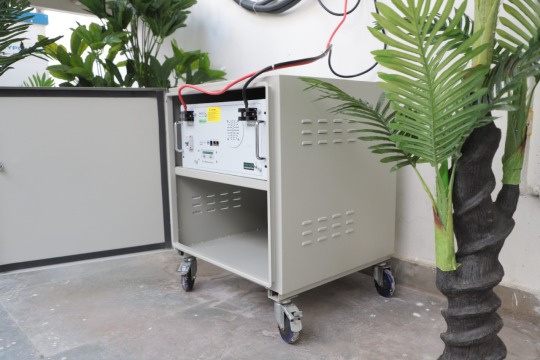
Well, first of all, let’s see why a lithium battery is a good option for you-
1. Power backup solution (inverter battery for offices, shops, medical clinic, farmhouse, etc.)
2. Electric Vehicles – Covert old scooter/bike to electric or plan to make new e-vehicles
3. DIY Projects – hydroponic farming, street shops, agricultural activities
4. Street Light – a college campus, ruler areas lights, etc.
5. Science Projects – school projects
Now, let’s have a glance at the best lithium battery manufacturers in India-
For more watch our youtube channel:
Top 10 Lithium Battery Manufacturer in India 2022
You must already be aware of the basics of lithium batteries on the internet, so skipping this part here are the best lithium battery manufacturers in India after researching online and offline market surveys based on retail consumer brands which have retail outlets in the local market:
Loom Solar – Energy Storage
Loom Solar is Haryana based Lithium Battery, a solar panel manufacturer that makes high-efficiency solar panels. Loom Solar also becomes the first lithium battery manufacturer to offer 6Ah to 100Ah with a reasonable lithium-ion battery price range in the consumer segment through retail channels and online marketplaces. With this B2C venture, the customer has the advantage to use for home applications, inverters, Electric vehicles, DIY, and science project.
Reliance – EV
Reliance New Energy Solar has bought Faradion, a UK start-up developing sodium-ion batteries. The Indian business investing in Faradion to speed up the commercialization of batteries for electric vehicles. Reliance will benefit both in renewable power storage as well as vehicles.
Mahindra – EV
Mahindra is a car manufacturer expanding aggressively into EVs. The company along with Hyundai and Reliance recently submitted bids under India’s battery scheme. They also launched the country’s first lithium-ion battery rechargeable powered auto-rickshaw, e –rickshaw, and cargo version.
Hyundai – EV
Hyundai one of the leading car companies in India has launched a premium electric vehicle, Kona. The company has partnered with a quantum computer firm, IonQ for battery development. They focus on improving the durability, capacity, the safety of lithium batteries used in cars.
Ola- EV
Ola was one of the ten Indian Companies to apply for the PLI scheme for battery manufacturing. Ola was one of the first few shared cab services to fray into electric feet. Back in 2017 Softbank through its company, Ola put a plan to run 1 million electric vehicles in India. They pledge to build the world's biggest electric scooter factory.
Amarraja (Amaron) – EV
Amazon is a powerful brand of the Amara Raja Group. It is a manufacturer of lead-acid batteries for both industrial and automotive applications of Indian storage batteries. It is also planning to make for a Giga factory to produce batteries for electric vehicles.
Exide – EV
Exide Industries is India’s largest selling battery company. They plan to participate in the PLI Scheme for the national program on ACC battery storage and it recently forayed into lithium-ion cell manufacturing.
Panasonic – Telecom
Panasonic offers a wide range of lithium-ion batteries used in small devices, backup batteries for emergencies, etc. It comes with long-term reliability suitable for outdoor devices in a wide temperature range. Panasonic batteries are thinner and lighter used in notebooks, computers, mobile phones.
LG – Telecom
The Korean giant is the No.1 lithium-ion battery manufacturer by capacity globally. The company is making strong lithium battery manufacturing and setting up a large manufacturing capacity worldwide.
Samsung – Telecom
Samsung is Korean based manufacturing company Samsung SDI has been struggling to improve the quality of products and ensure stability since they started the lithium-ion rechargeable battery business in 2000. E so they could lead small size marketplace.
Conclusion
In this article, we have explained lithium battery brands and their latest lithium products for you. Lithium battery is now also being used in military and aerospace applications. One can also use lithium batteries in electric vehicles, solar panels, inverters, chargers, electric tools, medical equipment, etc.
They can buy lithium batteries online at the most trusted lithium battery shopping website: www.loomsolar.com.
Loom Solar is the one-stop solution for lithium batteries where lithium consumers can buy lithium batteries, solar panels, inverter batteries, and balancing systems from anywhere in India as well as other countries, such as the USA, Bangladesh, Dubai, Canada, UAE, and more. We are delivering lithium and solar products across India including ruler areas within 3 to 7 days with proper safety at your home. Loom Solar provides lifetime investment products without analyzing better lithium performance, benefits, capacity, etc.
0 notes
Text
5 reasons to invest in Dholera Special Investment Region in 2021
1. India’s Electric Vehicle (EV) production center
The Gujarat authorities’s electric-powered car subsidy application has acquired lots note and acclaim, however, there may be something even greater exciting for traders. The Gujarat authorities are supplying EV manufacturers with a profitable unique subsidy of 12 percentage on constant capital funding. It additionally pursuits to look lakh EVs on Gujarat’s roads in the approaching 4 years. When that is blended with Dholera’s infrastructural improvement and similar funding opportunities sought through substantial automakers, the place is predicted to emerge as an outstanding EV production hub. This phenomenon will result in the technology of employment possibilities withinside the place and consequent residential actual property growth.
To supply credence, the Tata Group has introduced its purpose to construct a lithium-ion battery production manufacturing unit. In this regard, they've already bought 126 acres of land in the Dholera SIR Activation Zone. Dholera is likewise expected to advantage of the Central Government’s decided efforts to show India right into an international EV production powerhouse.
2. The flagship Special Education Region:
The Gujarat Special Education Region (G-SER) has been delivered to the Dholera SIR mission recently. This challenge is the primary of its type to appoint a Public-Private Partnership (PPP) method to strengthen an international training center. Until recently, Vallabh Vidyanagar in Gujarat’s Anand district become appeared as one of the exceptional instructional zones withinside the country. However, G-SER is now gearing up to elevate the bar through facilitating the advent of world-magnificence instructional centers related to domestic and overseas instructional institutions, for this reason bolstering the place's social amenities.
3. Upcoming Giga factories and Jio telephone manufacturing unit
The tendencies at Dholera SIR have come as opportunistic information for actual property traders. Dholera may even host the producing facility for 'JioPhone Next'. Google’s top brass has already all started surveying the place. If we integrate this challenge's development with the USD 8 billion really well worth of Giga plants, we will see next-era industrialization taking vicinity at Dholera.
4.The push for inexperienced strength alternatives
The world’s biggest single-location 'Ultra Mega Solar Power Park' with 5,000 MW potential has been deliberate in Dholera SIR after being accredited through the Central Government. In the Dholera Special Industrial Region, a sun molecular production plant with a potential of 2,000 MW is presently underway, with 15 MW already nearing completion.
5. Connectivity on a countrywide and global scale
Dholera International Airport’s Phase 1 production tenders have already been awarded, and Phase 2 tenders can be launched soon. In addition, the Central Government has accredited a suggestion to attach Ahmedabad, Dholera, and Gandhinagar through high-velocity metro rail. The challenge may have phases. Phase 1 will join Ahmedabad to Gandhinagar, at the same time as Phase 2 will hyperlink Gandhinagar to Dholera through GIFT City.
Besides the metro hall, the Gujarat authorities have granted the go-in advance for the State’s first monorail challenge, so one can run among Ahmedabad and the Dholera SIR. The monorail can be an improved structure, strolling parallel to the deliberate Ahmedabad-Dholera Expressway. The hall shall have seven stations. Dholera is likewise a part of the Delhi-Mumbai Industrial Corridor (DMIC).
Once complete, those delivery infrastructure tasks will pave the manner for neighborhood and global travel, inspire improvement withinside the surrounding areas, and entice large-scale residential actual property investments. With outstanding corporations making an investment in Dholera SIR and tasks just like the International Airport already starting to materialize, Indian traders must take complete benefit of the unprecedented opportunity. The destiny appears vibrant for traders as Dholera SIR is predicted to emerge as the following Dubai.
For More Details Reach to us
Royal Infra Dholera
https://www.royalinfradholera.com/
Mail Address:
Contact Address:
A-1009, Titanium Heights Opp. Vodafone House, Corporate Road, Makarba, Ahmedabad - 380015
Mobile:
+91 78630 90655
+91 90230 74854
0 notes
Text
Lucas TVS join hands with 24M to set up giga factory near Chennai
Lucas TVS join hands with 24M to set up giga factory near Chennai
Leading automotive electrical components manufacturer Lucas TVS and 24M Technologies, developer of next generation lithium-ion battery technologies, announced the signing of a license and services agreement to construct one of the first giga factories in India using 24M’s SemiSolidTM platform technology. The first plant will be set up in Thervoy Kandigai, Gummudipundi near Chennai and Lucas TVS…

View On WordPress
0 notes
Link
14:32 (IST)
Ola Electric S1 scooter launched in India, prices start at Rs 99,999: Check out performance, range and features- Technology News, Firstpost
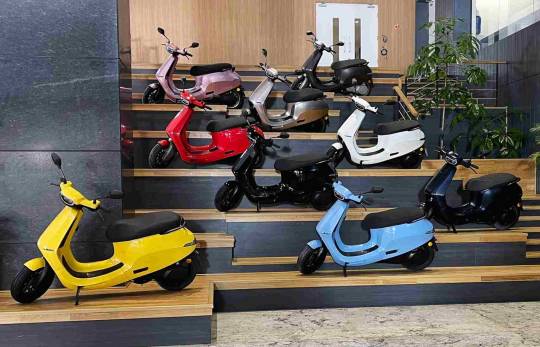
www.firstpost.com
14:25 (IST)
Ola Electric S1 prices (including state subsidies)
The Ola Electric S1 will be cheaper still in states with their own EV policies. Here's a look at what the S1 and S1 Pro will cost in Gujarat, Maharashtra, Delhi.
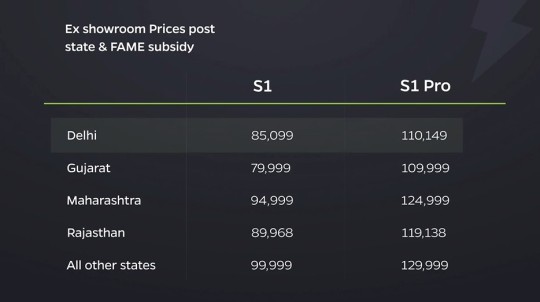
14:22 (IST)
Ola Electric scooter prices announced!
The Ola S1 starts at Rs 99,999, while the S1 Pro is priced at Rs 1,29,999 (including FAME-II subsidy).

14:19 (IST)
Ola S1 gets in-built speakers
The Ola Electric S1 e-scooter features built-in speakers, and users can also answer calls using the scooter's touchscreen. Additionally, it also gets cruise control!
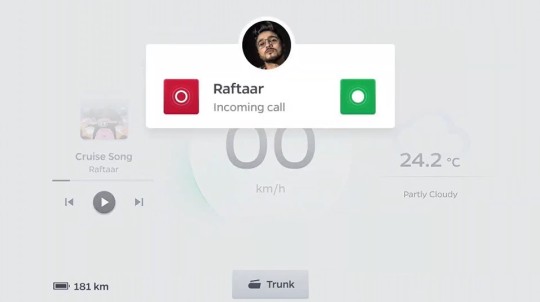
14:17 (IST)
Ola Electric S1 scooter: Display
Here's a look at the Ola S1's 7.0-inch touchscreen, which integrates real-time traffic updates and turn-by-turn navigation. Owners can also schedule a 'home' service using the screen.

14:15 (IST)
Ola S1 scooter to have four 'moods'
The Ola Electric S1 will have four 'moods', that will change the sound of the scooter - Bolt, Vintage, Care and Wonder.

14:13 (IST)
No key for the Ola electric scooter
Bhavish Aggarwal explains the Ola electric scooter won't have a key at all, with several functions controlled by voice commands.

14:13 (IST)
Ola S1 electric scooter performance details
The Ola Electric S1 has a 3.98 kWh lithium-ion battery, a top speed of 115 kph and a 0-60 kph time of just five seconds.

14:09 (IST)
Ola Electric scooter named 'S1'
The Ola Electric scooter is named the S1, and Bhavish Aggarwal says it is 'the best scooter ever built'.

14:06 (IST)
Bhavish Aggarwal gets the Ola Electric scooter launch underway
Ola Electric CEO Bhavish Aggarwal kicks off the Ola Electric scooter launch by highlighting the damage fossil fuels are causing to the environment, and highlights Ola's 'Futurefactory', which will have a production capacity of 10 million units per annum in the future. At full speed, the factory will produce an e-two-wheeler every two seconds.

13:59 (IST)
Ola Electric scooter to be home-delivered
Ola Electric CEO Bhavish Aggarwal confirmed Tech2's newsbreak (dated 21 July) in a tweet on 6 August, stating the company has received bookings for its e-scooter from over 1,000 cities in India, and that it will be delivering the scooters directly to buyers from Day 1. You can read the original story here.

13:51 (IST)
Watch the Ola Electric scooter launch LIVE
You can follow the live stream of the Ola Electric scooter launch right here.
13:40 (IST)
Ola Electric scooter: Expected real-world range of 150 kilometres
Armed with one of the biggest batteries seen on any electric two-wheeler on sale in India till date, the Ola Electric scooter is expected to have a real-world range of around 150 kilometres; something Tech2 revealed in July. You can read all about it here.

13:25 (IST)
Ola Electric scooter battery details and FAME-II subsidy eligibility
Tech2 has previously reported the top-spec S1 Pro variant of the Ola Electric scooter is likely to have a battery capacity of over 3.6 kWh, but the battery itself will be fixed, and not removable, as seen on the Etergo Appscooter. However, the high capacity lithium-ion battery means the scooter will be eligible for a FAME-II subsidy of well over Rs 50,000, and you can read more about it here.

13:14 (IST)
Ola Electric scooter colour options
Ola Electric has previously revealed its maiden electric scooter will be available in a total of ten colours. You can read all about them here.

13:07 (IST)
Ola Futurefactory: From then to now
This is what the site of Ola Electric's two-wheeler 'Futurefactory' looked like at the start of this year. Work on the facility began early in February this year, and about six months later, the company is nearly ready to commence mass-production, with the final touches being applied to the plant as you read this.
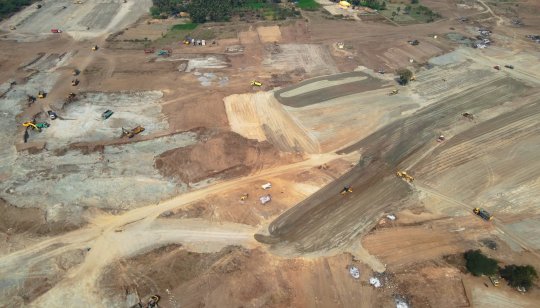
12:57 (IST)
Ola Electric scooter: The origins
If you're wondering, no, Ola has never been a vehicle manufacturer, but it decided to step into the electric mobility space and acquired Dutch start-up Etergo in 2020. It's Etergo's 'Appscooter' (pictured here) that the Ola electric scooter is based on, but while it looks largely identical in terms of design, it has a few key differences, which we shall get to in just a bit...
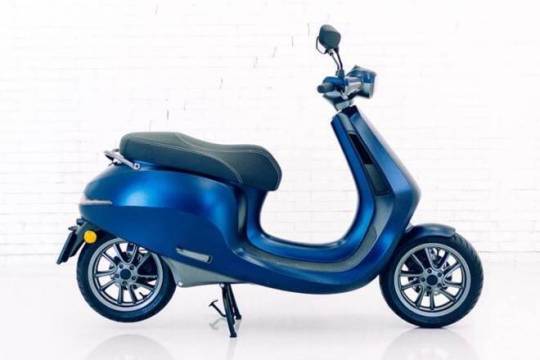
12:50 (IST)
Welcome to Tech2's live blog for the Ola electric scooter launch!
In just about an hour from now, Ola Electric will reveal all about its maiden electric scooter, including its specifications, prices and delivery timelines. We know many of you have been eagerly awaiting this one, so stay with us as we bring you all the updates straight from the launch event!

The day is finally upon us - Ola Electric is all set to launch its maiden electric scooter for India on the country's 75th Independence Day, marking its entry into a fast-evolving two-wheeler market. Over the last few months, Ola Electric has promised its scooter will deliver on performance, range and features, but will still be priced competitively, especially compared to other electric two-wheelers on sale today, and in just a while from now, we're about to find out how much the Ola electric scooter will cost, when will deliveries commence as well as its full specifications and features.
The Ola Electric scooter has the same banana-shaped batteries as seen on the Etergo Appscooter it’s based on; only here, they are fixed, and not removable. Tech2 has previously reported the top-spec Ola e-scooter – expected to be named the Ola S1 Pro – will have a battery capacity of close to 3.6 kWh; among the highest capacities for any electric two-wheeler on sale in India today, which would qualify it for a FAME-II incentive of more than Rs 50,000.
Given the Ola’s real-world range is likely to be as high as 150 kilometres, its ARAI-certified range figure would be higher still, expected to be somewhere between 180-190 kilometres. A lower-spec model – with a different battery configuration and markedly lower range – is also expected to be offered for cost-conscious buyers.
Ola Electric declared its electric scooter will have class-leading acceleration. It’s unclear at this time which scooters Ola considers to be its rivals, but for perspective, the Ather 450X – which is currently the quickest-accelerating e-scooter on sale in India – does 0-40 kph in 3.3 seconds and 0-60 kph in 6.5 seconds. The lower-spec Ather 450 Plus, on the other hand, can do 0-40 kph in 3.9 seconds and 0-60 kph in 8.29 seconds.
The Ola Electric Series S e-scooter also claims to have the largest under-seat storage in its category, with the ability to accommodate two half-face helmets. It will also have a side-stand cut-off function, a virtual switch to unlock the seat incorporated into the large colour instruments display and an e-SIM for connectivity features. It will be available in a total of ten colour options.
Ola’s electric scooter has a single-sided telescopic front suspension and horizontally mounted rear shock absorber, as well as slotted front and rear disc brakes. The pillion foot pegs fold flush into the scooter’s bodywork, and at the back, the Ola electric scooter gets a chunky pillion grab handle and a clear-lens tail-light.
Ola Electric will have fixed charging stations (including slow- and fast-charging points) in 100 cities across India at the time of the Series S’ launch, and will eventually cover more than 400 cities. Its decision to sell directly to buyers online and deliver the scooter to their homes (first reported by Tech2) also means it can retail and service its e-scooter in practically every city in India right from day one.
source https://www.firstpost.com/tech/auto-tech/ola-electric-scooter-launch-highlights-prices-start-at-rs-99999-with-the-s1-pro-having-a-range-of-up-to-181-kilometres-and-top-speed-of-115-kph-9888101.html
0 notes
Text
Global Lithium Ion Battery Market 2021 Industry Key Players, Trend, Analysis and Forecast to 2027
Summary
A New Market Study, titled “Global Lithium Ion Battery Market Upcoming Trends, Growth Drivers and Challenges” has been featured on Market Research Future.
The Global Lithium Ion Battery Market is growing at a rapid pace. The market growth attributes to the increasing demand for high power and capacity batteries. These lithium-ion batteries are extensively used across end-use industries due to their extended life cycle, high energy density, better performance, and higher reliability. The increasing usages of these batteries in a range of applications boost the growth of the market. Moreover, the augmenting demand for smart devices and other consumer electronics escalates market growth to furthered height.
According to Market Research Future (MRFR), the Global Lithium Ion Battery Market is estimated to create a valuation of approximately USD 62 BN by 2023, growing at 16% CAGR throughout the review period (2017-2023). Substantial investments and significant funding for R & D activities to improve the lithium supply technology that can cut down the battery's overall cost influence market growth. The increasing proliferation of electric and hybrid vehicles positively impacts the growth of the market.
Additionally, increasing production capacities and advanced lithium-ion battery plant manufacturing future-generation electric vehicle batteries push the market growth. Conversely, high costs of lithium-ion batteries are a key factor projected to impede the growth of the market. Also, the demand-supply gap in a key raw material graphite anode restricts the market growth, disrupting the entire lithium-ion battery supply chain. Nevertheless, the increasing demand from the consumer electronics and automotive sectors worldwide would support the market growth throughout the assessment period.
Global Lithium Ion Battery Market - Segment
The report is segmented into four dynamics;
By Type: Lithium Nickel Manganese Cobalt (LI-NMC), Lithium Cobalt Oxide (LCO), Lithium Iron Phosphate (LFP), Lithium Titanate Oxide (LTO), Lithium Nickel Cobalt Aluminum Oxide (NCA), Lithium Manganese Oxide (LMO), and others.
By Power Capacity: 0 to 3000mAh, 3000mAh to 10000mAh, 10000mAh to 60000mAh and more than 60000mAh.
By Vertical: Automotive, Aerospace & Defense, Consumer Electronics, Industrial, Marine, Medical & Power, and others.
By Regions: Asia Pacific, Americas, Europe, and the Rest-of-the-World.
Complete Report Details @ https://www.marketresearchfuture.com/reports/lithium-ion-battery-market-979
Lithium-ion Battery Market -Regional Analysis
Asia Pacific leads the Global Lithium Ion Battery Market. The largest market share attributes to the spurring demand from the automotive sector in the region. Besides, rising technological advancements in battery technologies and the increased adoption of consumer electronic products across various industry verticals in the region foster the growth of the market. Furthermore, increased R&D activities and the rapid economic growth in the region propel market growth. The APAC lithium-ion battery market is projected to retain its dominance throughout the estimated period.
Europe region is another lucrative market for lithium-ion batteries. The market is especially driven by the presence of the well established automotive industry in the region. Moreover, the increasing adoption of the battery across industry verticals such as aerospace & defense, consumer electronics, industrial, marine, and medical & power, fuel the lithium-ion battery market size.
Substantial investments by the existing major industry players in R & D activities required for product and technology developments fuel the lithium-ion battery market demand. Additionally, the government's increasing focus towards reducing greenhouse gas emissions and the rise in the number of power outages boost the European lithium ion battery market share.
North America also holds a sizable share in the Global Lithium Ion Battery Market. Factors such as the increasing adoption and implementation of battery technologies across vehicle applications foster market growth. Besides, the presence of many automakers and industry players in the region drives the lithium ion battery market growth.
Moreover, substantial investments to incorporate increasing eco-friendly initiatives & raising technological advances in vehicles influence regional market growth. The North American lithium-ion battery market is estimated to grow at a significant pace during the assessment period.
Global Lithium Ion Battery Market – Competitive Analysis
Highly competitive, the lithium-ion battery market appears fragmented due to the presence of several well-established players. Industry players run programs featuring easy lookup on an online application catalog that can be accessed through the world. They strive to offer an extended range of batteries for replacement vehicle applications, from motor mounts to hose assemblies.
To gain a larger competitive share, industry players initiate strategic approaches such as mergers & acquisitions, innovation, brand reinforcement, and expansion. Due to the expected innovations and improvements in product, service, and product innovations, the market is soon expected to witness an intensified competition.
Major Players:
Players leading the Global Lithium Ion Battery Market include Automotive Energy Supply Corporation (AESC - Japan), Panasonic Sanyo (Japan), LG Chem. (South Korea), Li-Tec Battery GmbH (Germany), SAMSUNG SDI Co., Ltd. (South Korea), Toshiba (Japan), GS Yuasa (Japan), A123 Systems (US), SK Energy (South Korea), Sony Corporation (Japan), BYD (China), Beijing Pride Power (BPP) (China), Toshiba Corporation (Japan), BAK Group (China), Valence Technology, Inc.(US), Johnson Controls, Inc.(US), Hitachi Chemical Co. Ltd.(Japan), Saft Groupe SA (France), and TDK Corporation(Japan), among others.
Industry/ Innovation/ Related News:
July 30, 2020 ---- Northvolt AB (Switzerland), a leading battery developer and manufacturer, announced raising funds for lithium-ion battery cell factories consortium of commercial banks, pension funds, and public financial institutions to develop factories and R&D investments. The company is also making notable investments in battery cell technology & process development, and recycling at the recently established industrialization factory, Northvolt Labs in Vasteras Sweden, which produced its first battery cells in late 2019.
Most Popular Market Research Reports:
Mobile Robotics Market @ https://www.marketresearchfuture.com/reports/mobile-robotics-market-1946
Next Imaging Technology Market @ https://www.marketresearchfuture.com/reports/next-imaging-technology-market-1154
Noise Monitoring System Market @ https://www.marketresearchfuture.com/reports/noise-monitoring-system-market-4064
OLED Microdisplay Market @ https://www.marketresearchfuture.com/reports/oled-microdisplay-market-7479
Optical Sensing Market @ https://www.marketresearchfuture.com/reports/optical-sensing-market-3260
About Market Research Future: Market Research Future (MRFR) has created a niche in the world of market research. It is counted among the top market research companies that offer well-researched and updated market research reports and insights to businesses of all sizes. What sets us apart is our super-responsive team that offers quality work keeping clients abridged of the prospective challenges and opportunities in various markets. Our team is adept in their space as well as patiently listens to every client.
Contact Market Research Future Office No. 528, Amanora Chambers Magarpatta Road, Hadapsar, Pune - 411028 Maharashtra, India +1 646 845 9312 Email: [email protected]
0 notes
Text
Automotive Battery Manufacturers in Delhi | Charge My Gaadi
Whether it’s a Delhi market or Indian Automotive market, battery market is flooded with Make in India batteries. We have a list of companies serving various clients in India for the supply of batteries in no time with different categories solutions on board. China being the strongest of all, also being the largest battery manufacturer in world. India is also reporting significant growth in battery productions with the impeccable growth in sales sector. India administered the ever-highest growth after the hike in covid cases in the country with zeal of AtmaNirbharBharat and will develop to Indian products in the market.
Though there is a list of battery manufacturers in India, few of them earlier importing batteries from China and re-sale them in India, however this picture is changed now. People are just importing raw material from China if needed, else all the battery manufacturing is being witnessed by India here itself. The battery industry in India comprise of automobile, SMF i.e Sealed maintenance free, tubular and Lead Acid batteries, with Lithium-Ion batteries witnessing a hike after many hurdles, all are registering a growth of 25-30% in the industry. With the Lithium-Ion batteries taking the place of Lead Acid batteries in coming time. India is expected to administer a sharp increase in sales by the end of this year. Automotive battery manufacturers in Delhi have become one of the essentials markets of the country. Delhi is becoming the hub of battery suppliers in India. Even the demand of importers for the Indian batteries has also geared up at a faster pace. Battery makers have their eyes set on the India Lithium-Ion market which is witnessing the attention of many. In India, about 3 million fossil fuels powered vehicles are sold. The country’s EV policy is geared up towards two-wheelers, three-wheelers, and toward public transportation. Automotive battery manufacturers in Delhi played a major role in setting up the market for various states and working even as a hub for many. ChargeMyGaadi works in close collaboration with many battery OEMs to work as together for vehicle manufacturing companies.

ChargeMyGaadi’s main objective to work with battery OEM’s is to facilitate the full package for two-wheelers and three-wheelers, as both can be supplied with the vehicles. Even the Mumbai based firms are setting up the manufacturing units for Lithium-Ion battery components. The plants are being set up in Karnataka. The covid-19 pandemic has brought us to the fact that India must become a self-reliant country to tackle the other countries and by not being dependent on other country. India is planning and following an aggressive EV policy. Public transport has become the first step of EV policy by the government. The various states are adopting this aggressively to promote the adoption of EVs and EV technology. There are many firms which are setting-up the manufacturing units for the raw materials of Lithium-Ion batteries and chargers. The companies are even setting up the target-oriented research and development laboratory to improve the quality of material further.
Automotive battery manufacturers in Delhi played a major role in developing market for the country. There are many companies, factories, manufacturing units that are being set-up to promote the EV adoption in the state and country. Lead Acid batteries and Lithium-Ion batteries are being manufactured at a wider scale. Though, Lithium-Ion batteries and chargers are going to dominate the state and country in coming time. Country is in urgent need of Electric mobilization not because of hundreds of reasons but just one reason of pollution.
#Electric car battery suppliers in Delhi#automotive battery manufacturers in delhi#Car battery manufacturers in Delhi#EV Car Battery Manufacturers in Delhi#EV Electric car battery suppliers in Delhi
0 notes
Link
India Electric Vehicle Powertrain Market has valued US$ XX Bn and expected to reach US$ XX Bn in 2026, at CAGR of 26% during forecast period.
Strict regulations on emission and fuel efficiency, government schemes towards implementation of electric vehicles coupled with the need for pollution free environment are few of the factors contributing to the growth of electric vehicle powertrain systems market in India. The growth of the electric vehicle market is also critical for energy transition in the country, reducing the belief on oil imports and rising demand for renewable power. Additionally, technology improvement, cost reduction and local manufacturing of lithium-ion batteries are expected to catalyse the growth of the Electric Vehicle market in India.
Battery EV powertrain systems captured a majority of the market share in terms of revenues, owing to the subsidies and tax reductions offered by the government to EV users and manufacturers. Although, charging infrastructure challenges are still present, however, the government's target of 6 million EVs on roads backed by its firm actions is likely to overcome these challenges during the forecast period.
High cost and lack of charging infrastructure are posing challenges towards the expansion of the market in the country. Mostly, the lithium-ion batteries make EVs highly expensive; however, with local manufacturing of batteries, a significant decline in prices are expected over the coming years.
Among several EV powertrain components, lithium-ion battery segment captured majority of the market share. Additionally, passenger car powertrain segment bagged the highest share among different vehicle types including commercial vehicles as well as two and three wheelers.
Suzuki Motor Corp., the parent of India’s largest carmaker, aims to produce as many as 35,000 electric cars annually in India starting 2020-21 when it rolls out the first of these cars in the country.
Suzuki will venture into the electric vehicle market quite late compared to some of its competitors. So that company wanted to make sure the mission into electric should be supportable and gradually gain volume. Battery plant was critical and now the management has internally decided on 30,000-35,000 units per annum from FY21.
While challenges such as Mahindra and Mahindra Ltd and Tata Motors Ltd are already manufacturing electric vehicles by sourcing half of the components from overseas vendors, Suzuki plans to set up the full ecosystem, starting with a lithium-ion battery plant, before unit Maruti begins selling the vehicles in India.
Suzuki will source technology from Toyota Motor Corp. and Denso Corp. for the development of a compact and ultra-high-efficiency powertrain for India and other global markets. Suzuki also has a tripartite joint venture with Denso and Toshiba to set up a lithium-ion battery factory in Gujarat.
India’s growing green initiative is likely to pose a great opportunity for both BEVs and Hybrid Electric Vehicles (HEVs) over the coming years. Further, Government’s aim of 100% electrification by 2030 would provide immense growth to BEVs.
Key players operated in the market includes AVTEC Ltd., Hyundai Motor India Limited, Mahindra Reva Electric Vehicles Ltd., Maruti Suzuki India Limited, Tata Motors Limited
For more information visit:
https://www.maximizemarketresearch.com/market-report/india-electric-vehicle-powertrain-market/20097/
Scope of India electric vehicle powertrain market:
India electric vehicle powertrain market by Technology:
• Battery Electric Vehicle Powertrain
• Hybrid Electric Vehicle Powertrain
India electric vehicle powertrain market by Component:
• Transmission
• Battery
• Motor/Generator
• Engine
• Controller
India electric vehicle powertrain market by Vehicle Type:
• Passenger Cars
• Two-Wheelers
• Commercial Vehicles
• Three-Wheelers
Key players operated in India Electric Vehicle Powertrain Market:
• AVTEC Ltd.
• Hyundai Motor India Limited
• Mahindra Reva Electric Vehicles Ltd.
• Maruti Suzuki India Limited
• TATA Motors Limited This Report Is Submitted By : Maximize Market Research Company
Customization of the report:
Maximize Market Research provides free personalized of reports as per your demand. This report can be personalized to meet your requirements. Get in touch with us and our sales team will guarantee provide you to get a report that suits your necessities.
About Maximize Market Research:
Maximize Market Research provides B2B and B2C research on 20,000 high growth emerging opportunities & technologies as well as threats to the companies across the Healthcare, Pharmaceuticals, Electronics & Communications, Internet of Things, Food and Beverages, Aerospace and Defense and other manufacturing sectors.
Contact info:
Name: Lumawant Godage
Organization Address: MAXIMIZE MARKET RESEARCH PVT. LTD.
Email: [email protected]
Address: Pune, Maharashtra 411051, India.
Contact: +919607195908
0 notes
Text
AirPods Are a Tragedy
Future Relics is a column about the objects that our society is currently making, and how they may explain our lives to future generations. In each article, we’ll focus on one item that could conceivably be discovered by someone 1,000 years from now, and try to explain where this item came from, where it’s going, and what its existence explains about our current moment.
AirPods are a product of the past.
They’re plastic, made of some combination of carbon, hydrogen, oxygen, nitrogen, chlorine, and sulfur. They’re tungsten, tin, tantalum, lithium, and cobalt.
The particles that make up these elements were created 13.8 billion years ago, during the Big Bang. Humans extract these elements from the earth, heat them, refine them. As they work, humans breathe in airborne particles, which deposit in their lungs. The materials are shipped from places like Vietnam, South Africa, Kazakhstan, Peru, Mexico, Indonesia, and India, to factories in China. A literal city of workers creates four tiny computing chips and assembles them into a logic board. Sensors, microphones, grilles, and an antenna are glued together and packaged into a white, strange-looking plastic exoskeleton.
These are AirPods. They’re a collection of atoms born at the dawn of the universe, churned beneath the surface of the earth, and condensed in an anthropogenic parallel to the Big Crunch—a proposed version of the death of the universe where all matter shrinks and condenses together. Workers are paid unlivable wages in more than a dozen countries to make this product possible. Then it’s sold by Apple, the world’s first trillion-dollar company, for $159 USD.
For roughly 18 months, AirPods play music, or podcasts, or make phone calls. Then the lithium-ion batteries will stop holding much of a charge, and the AirPods will slowly become unusable. They can’t be repaired because they’re glued together. They can’t be thrown out, or else the lithium-ion battery may start a fire in the garbage compactor. They can’t be easily recycled, because there’s no safe way to separate the lithium-ion battery from the plastic shell. Instead, the AirPods sit in your drawer forever.
Kyle Wiens, CEO of iFixit, which does electronics teardowns and sells repair tools and parts, told Motherboard that AirPods are “evil.” According to the headphones review team at Rtings.com, AirPods are “below-average” in terms of sound quality. According to people on every social media platform, AirPods are a display of wealth.
But more than a pair of headphones, AirPods are an un-erasable product of culture and class. People in working or impoverished economic classes are responsible for the life-threatening, exhaustive, violent work of removing their parts from the ground and assembling them. Meanwhile, people in the global upper class design and purchase AirPods.

Image: Screenshot from Twitter/@dnanian
Even if you only own AirPods for a few years, the earth owns them forever. When you die, your bones will decompose in less than a century, but the plastic shell of AirPods won’t decompose for at least a millennia. Thousands of years in the future, if human life or sentient beings exist on earth, maybe archaeologists will find AirPods in the forgotten corners of homes. They’ll probably wonder why they were ever made, and why so many people bought them. But we can also ask ourselves those same questions right now.
Why did we make technology that will live for 18 months, die, and never rot?
THE SOCIAL LIFE OF AIRPODS
AirPods aren’t the most expensive pair of wireless earbuds on the market. Some luxury wireless earbuds cost upwards of $730. Other companies like Sennheiser sell wireless earbuds for $300. Bose sells its pair for about $200.
Mark Henny, the head of headphone reviews for Rtings.com, said that the AirPods offer a lot of value for the price point despite a rating of “below average” sound quality. “You also have much cheaper models, but for the quality of the craftsmanship of the AirPods, from the case to the actual earbuds, and also for the reliable wireless connection, the battery life—the price of the AirPods is actually pretty fair,” Henny told Motherboard.
And yet, at least on social media, AirPods have become a meme that automatically inducts owners into the bourgeoisie.
Part of the joke may have to do with the fact that AirPods are, well, tiny. They’re incredibly easy to lose, or accidentally launder with your clothes. By virtue of their size alone, AirPods are a risky purchase. AirPods communicate that you can afford to buy them, but also lose them.
There’s an irony here, since you can’t ethically or practically repair, recycle, or throw away AirPods. They’re two small, untethered objects that hang from a person’s ear and are designed to be worn at any time—especially when you’re commuting, walking, or exercising. Lots of people lose their AirPods.
But let’s say you don’t lose your AirPods, and instead, you throw them in the trash when they stop holding their charge. The AirPods don’t just go away. They become someone else’s problem. Then, long after you’re dead, AirPods will still be sitting, and not decomposing, in the crust of the earth.
Owning AirPods embodies what it means to be “rich” in the same way as this picture of Kanye West haphazardly holding his laptop.
Before, the idea of expendable wealth was limited to the likes of multimillionaires like West. But now, AirPods have normalized the idea that anyone can demonstrate expendable wealth to the world. If you’re “courageous” enough to invest in a pair of AirPods, there’s a sense that losing them is not a big deal. On TikTok, this sentiment fueled a meme in which people pretend to flush their AirPods down the toilet.
Another common AirPod meme is some iteration of “Oh my god, they have AirPods in, they can’t hear us, oh my god,” featuring a picture of someone approaching a life-ending situation. The joke suggests that people who wear AirPods act as if they’re celebrities, detached and elevated from their environment, and too good to listen to those around them. In reality, AirPods have pretty poor noise isolation (Rtings.com gave AirPods a grim score of 3.6 out of 10 on that quality.)
The meme also suggests that people who wear AirPods never want to take them off. They want to show the world that they’re wealthy, even if it leads to their demise. It’s a way of poking fun at the rich and labeling their lives as disposable.

Image: Dopl3r.com.
Compared to other wireless earbuds, AirPods are visually distinct. While many brands opt for subtlety and make their earbuds black and antennaless, Apple made a product that looks like the head of an electric toothbrush.
Early AirPod reviews called the product “dorky” and described its appearance as “controversial.” But even if AirPods are strange-looking, they’re incredibly conspicuous and instantly recognizable. Being willing to ignore the weird appearance of AirPods makes a statement: if you’re okay with overlooking how strange-looking they are, then you must be somewhat proud to be wearing them.
In reality, most people aren’t actively trying to make a statement by wearing AirPods. Practically speaking, there are valid reasons to own AirPods: Unlike other Bluetooth headphones, they connect instantly to the iPhone. Also, since Apple removed the headphone jack, normal wired headphones can only be used with a small, easy-to-lose dongle (or Apple’s proprietary Lightning headphones.)
Some people have actively embraced the distinct appearance of AirPods. For instance, Twitter user @bloodorgy made AirPod earrings called “Airrings,” which she’s selling for $20.
Dozens of Etsy merchants sell knock-off cases for AirPods featuring the logos of luxury companies like Gucci, Louis Vuitton, and Supreme. (All of these products are counterfeit. None of these companies actually make AirPod accessories that fall within the Apple canon of official products.)

Image: Screenshot from a now-removed Etsy listing of $36 Supreme casing for an AirPod case.
AirPod owners often acknowledge the status that AirPods project, but resist the notion that they demonstrate disposable wealth, or wealth generally. “I go to a very spoiled school, which is partly why I wanted AirPods, so I’d fit in better,” Reddit user CrispViolet, who identified as Ally, told Motherboard. Ally has posted in the AirPod-focused subreddit, r/airpods.
Ally also said that they don’t think AirPods demonstrate wealth. “Some of my friends don’t have AirPods because they have more expensive headphones used for gaming,” Ally said. “I do find the memes funny though, and honestly the AirPod sound isn’t very good, as it should be for its price.”
Another redditor, weab00, told Motherboard in a direct message that they got AirPods for Christmas. “There’s definitely something to be said about how it makes you look basic and like you want to be trendy, but I personally use them for their convenience.”
“In fact, sometimes I get a bit self conscious because I’m afraid people will think I’m bougie, which is partly because Reddit can be pretty toxic about them,” they added. “They’re so common that wearing them is not even a flex at this point. Literally everyone is LA has a pair.”
The disposability of AirPods mirrors the fact that they were built upon disposable labor.
Disposable labor refers to the workers who are subject to the whims of what capitalists call the “invisible hand of the market.” When there’s demand for a product or service, these people have work. When there isn’t, these people don’t. These could be contractors, part-time workers, or low-wage blue collar workers who are treated like a “replaceable part of the production process,” as explained by socialist writers Fred and Harry Magdoff in an article for the Monthly Review.
Every electronic product is the culmination of international labor from mines, refinery facilities, and assembly facilities, usually from underpaid workers. Thousands and thousands of people work in dozens of countries around the world—including, but not limited to, Brazil, Indonesia, Taiwan, Thailand, China, Malaysia, Brazil, Bolivia, Peru, India, the Philippines, Mexico, Kazakhstan, Vietnam, Russia, Japan, Germany, Belgium, Estonia, Macedonia, Korea, Canada, and Netherlands—in order to extract and refine the materials used to make modern electronics.
There’s a human cost to all of this. Consider Foxconn—the Chinese company that assembles an estimated half of all iPhones, according to Business Insider, as well as other Apple products. (Luxshare and Investec assemble AirPods.) Foxconn has a factory in Zhengzhou that’s sometimes referred to as “iPhone City.” According to reporting by Business Insider from May 2018, about 350,000 people work in these facilities. Salaries start at $300 per month. And for years, Apple sourced cobalt and tantalum—which are used to power lithium-ion batteries and protect conductors on logic boards, respectively—from the Democratic Republic of the Congo (DRC). Only after extensive reports of child labor, worker injuries, and worker deaths did Apple stop sourcing these materials from small mines in the DRC specifically.
Consumers aren’t supposed to know or think about these stories. Apple doesn’t want us to know the details of the supply chain.
Marx argued that commodities—or products meant to satisfy “wants”—don’t derive their value from their use. That’s because by definition, they aren’t necessary for basic survival. Rather, they derive value from the invisible labor that goes into making them. Apple’s products take value from dirt, blood, sweat, and tears you don’t see on its clean, white packaging. They take value from human aches, pains, and fatigue.
Commodities like AirPods are social products. AirPods display the social message of wealth because AirPods derive their value from the invisible, social chain of production that’s necessary to make them in the first place.
APPLE’S STORY OF THE AIRPOD
According to Apple, AirPods are part of a larger vision for a “wireless future.” The Apple website introduces AirPods by stating, “Wireless headphones. Finally untangled.” Wires, Apple argues, are a burden. Thus, AirPods are a product of liberation.
It’s true that wires are, arguably, annoying. They get tangled. They snag on things. They flap around when you’re exercising. The plastic casing around the wires are often prone to tearing, exposing the wire, and rendering the headphones useless. But Apple’s sales pitch of liberation is not so straightforward. AirPods were introduced in 2016 alongside the debut of the iPhone 7 and 7 Plus, which eliminated the headphone jack. The earbuds are designed to seamlessly switch from iPhone to MacBook to Apple Watch, depending on which device you’re using.
Thus, AirPods strategically glue together an ecosystem of luxury products. They are only so “convenient” because, by eliminating the headphone jack, Apple made the iPhone less user-friendly.
Destroying the mild nuisance of headphone jacks comes at two costs: One, it locks people into a system of limited, compatible, proprietary products that are inevitably going to die in a few years. And two, it creates a dilemma at the product’s end of life. If you try to recycle AirPods, a worker at a recycling plant will have to engage in the risky and mundane task of separating the glued-in lithium-ion battery from the plastic. If you try to throw AirPods away, you run the risk of starting a fire in a garbage compactor facility. And if AirPods wind up in a landfill, the earth will embed the earbuds into its crust for at least a thousand years.
AirPods were destined to become e-waste from the moment they were manufactured. And AirPods become e-waste after just eighteen months, when the irreplaceable lithium ion battery dies.
“I would put this in the planned obsolescence category of products, but it’s not really planned obsolescence, it’s planned failure,” Wiens told Motherboard. “When they made these products, they knew they were only gonna last for 18 months. They didn’t put that on the outside of the box, knowing that the battery is not replaceable, and here we are.”
AirPods are disposable products that are also impossible to throw away.
Sound has always been important to Apple—at least, from a marketing perspective. The company fundamentally changed music distribution with the creation of the iPod and the digital music marketplace iTunes, which fueled the proliferation of the MP3. Bright white headphones were the focal point of iPod advertisements through the mid-2000s.
But Apple has never sold AirPods as the best-sounding headphones in the world. In a two-minute AirPod promotional video, the actual audio quality of the product isn’t mentioned until the second-to-last sentence. (“And of course, the new wireless AirPods deliver incredible sound.”) The core of Apple’s AirPods marketing is the fact that they’re wireless.
“There’s so much technology packed into each AirPod,” Apple’s vice president of marketing Philip Schiller said when he first introduced AirPods. “There’s the chip, there’s the dual accelerometers, optical sensors, beamforming microphones, antennas, batteries—it is a technical tour de force in this minute little AirPod.”
What makes AirPods perform better with iPhones than other wireless headphones is its W1 wireless chip, which does three things:
It helps the earbuds communicate with your phone, computer, and with each other.
It enables fast device pairing, without needing to go into iOS system preferences.
It makes AirPods compatible with Siri, and able to make phone calls.
But the underlying technology that makes AirPods possible is Bluetooth (or using radio waves to send data like sound from device to device). Jim Kardach—a now-retired Intel employee who gave “Bluetooth” its name—told Motherboard that Bluetooth was conceived to be “your people’s wireless,” since Bluetooth capabilities are so cheap. Yet companies that want to sell luxury often sell Bluetooth technology as if it’s expensive.
Apple did not return Motherboard’s requests for comment.
Kardach told Motherboard that he thinks about this when he sees advertisements for luxury cars advertising built-in Bluetooth. “This Jaguar is a super expensive car and they can brag about almost anything,” Kardach said. “The cost of putting that Bluetooth radio into the Jaguar probably cost them about a dollar, yet it’s one of the three things that they talk about when they advertise.”
AirPods have a regular Bluetooth antenna in the stalk below the earbud area. In and of itself, it’s straightforward wireless technology that’s been around for twenty years.
HARALD BLUETOOTH, SON OF GORM
Kardach named Bluetooth technology after Harald Bluetooth, a Viking king who ruled Denmark in the first century AD. According to Kardach, the goal of Bluetooth technology was to unite radio, cellular, and digital technologies. Similarly, King Bluetooth united ancient Denmark and Norway, creating one Scandinavian kingdom.
“I went to my marketing guy and I said, ‘hey, we should call this program Bluetooth,’ he says ‘you’re crazy,’” Kardach said. “I said, ‘Yeah, look at this runing stone.’ I had outlined Harald Bluetooth in a Sharpie. I had scanned it and printed it out and outlined it with a Sharpie and he said, ‘Ooh that’s good. Can you put a cellphone and a notebook in his hand?’ And I drew a cellphone and a notebook. And he said ‘Oh that’s perfect, we’ve gotta do this.’”

Image: Jim Kardach
Bluetooth technology was inspired by archaeology, and stories of the past. Now, it’s being used to create products like AirPods: Technology that was designed to live for a few months, stop working, and sit in the earth long after we’re gone.
Of course, AirPods aren’t unique. Many of the products that we use daily were built to become trash, and eventually fossils. Single-use plastics—like water bottles, coffee cups, plastic packaging—are cheap for companies and convenient for consumers. They also, largely, end up floating in the ocean and littering ocean floors. Some scientists have even started to refer to the present as the Plasticine. Electronics are no different. For companies like Apple, product repairability hurts the bottom line, so the company has lobbied against right-to-repair efforts and collaborated with Amazon to boot iPhone and Macbook refurbishers off the Amazon marketplace.
On a global scale, our economic system is predicated on a disregard for longevity, because it’s more profitable for companies to make products that die than it is to make products that last.
So sure, AirPods aren’t the most expensive earbuds on the market, and the jokes that the product is a display of wealth are largely tongue-in-cheek. But in truth, AirPods are a symbol of wealth. They’re physical manifestations of a global economic system that allows some people to buy and easily lose $160 headphones, and leaves other people at risk of death to produce those products. If AirPods are anything, they’re future fossils of capitalism.
AirPods Are a Tragedy syndicated from https://triviaqaweb.wordpress.com/feed/
0 notes
Text
Research Project
Cade Lewis
Research Project
Fish Burton
December 2nd, 2019
The inevitable advancement of electric cars
The world has never been so dark. We look around every day, and we see the outcome of our own doings, and our own mistakes. Looking back at previous times, we can see the success and growth of America as it once was. Before this, there was much happiness and joy. There still is a sense of joy, but it is much different. In previous times, the only sense of obligation was going to your job, trying to support your family. But now there lies a greater problem, which is in its entirety, advancing the world in a whole different way that we never thought would ever be possible in this lifetime.
It seems unfair to make a claim the world is so dark and depressing. But the truth and the reality are, that the world is slowly becoming a trap for those individuals who suck themselves into the different aspects of the world. There are phones, social media, drugs, alcohol, strip clubs, parties. People think that these things will make them happy. What they don’t realize is that the future of the world lies in something quite deeper than what we might think. And the answer is the future of electric cars, and taking advantage of lithium ion to progress and really make an impact on our way of life. Believe it or not, the electric cars of today have changed the way people live. How? Because they make people's lives easier. They eliminate small decisions that we make every day, so that we can focus on other aspects of our life.
When we look at the origin of Tesla, we can see that the world today has become a much better place because of Tesla cars making people’s lives easier. Here’s a great quote that talks about how the world is going to change for the better. “This could be the most important shift since the Cambrian explosion of the smartphone. Car-sharing continues to increase (Uber and Lyft are set to go public this year), new innovations emerge all the time (Scooters! Vertical take off and landing vehicles!) and all manner of autonomous technologies are inevitable (Elon Musk, whatever you think of him or the prospects of Tesla, is 100 percent directionally correct).” (Swisher). When we look back at cars previous to Tesla, we can see that the cars back then also helped make people’s lives easier. When the first car was invented, they drove it around for a while and then, someone decided to invent windshield wipers. This invention was able to help people because now they could drive in the rain, and not worry about crashing their car. The first cars were made to be a help to all people.
A quote from Daimler says, “The first stationary gasoline engine developed by Carl Benz was a one-cylinder two-stroke unit which ran for the first time on New Year’s Eve 1879. Benz had so much commercial success with this engine that he was able to devote more time to his dream of creating a p car powered by a gasoline engine, in which the chassis and engine formed a single unit.” (Daimler) We can see here that what Carl Benz was trying to do, is create a lightweight car that could better society. Another invention that really helped was TCS. This stands for traction control stabilization. What this means is that it’s an electronic system that actually can help for when the roads get slick for your car. This is a much newer invention but it relates to what we’re talking about because it is an invention to make people’s lives easier so that they can focus on their day to day activities.
I want to start by talking about why you would even want an electric car. We look at all the people today who have gas cars. They try to figure out the benefits of a gas car versus an electric car but really, they don’t understand the big picture. What people don’t understand is the long-term effects. Over time, fossil fuels are going to run out. At this point we’re going to have to make some tough decisions. With anything in this world, we’ve always planned ahead. We have always been able to look to the future and predict or foretell something that is going to come. And what is going to happen, is that the fossil fuels are going to run out and people are going to be stuck driving gas cars and we are going to have to conserve the gas that we use. There are many other things that we use gas for, but really the key is to convert everything to electric. Not just cars, but power plants and factories and buildings and whatever else we want to run on electric power and batteries. Lithium ion is one of the greatest substances known to man for his ability to hold energy and use that energy effectively.
One thing to note as we move forward though, is that electric cars are a very fast growing market. In a study done in 2017, electric vehicle purchases were up 30% to about 200,000 units. Personally when I look at this I feel that that is a significant amount of electric cars that were purchased in one year. Especially given the fact that the Tesla model 3 was barely on its way.
There are quite a few initiatives in multiple countries that are now banning the sales of oil based vehicles. This is said to happen within the next couple decades, but what they are doing is trying to weed out all the gas vehicles so that their air will be cleaner and more efficient. A few of these countries will be China, India, and Norway. Given this fact, what we don’t realize is that again, the electric car is still using fossil fuel.
How could this be possible? Is because most of the electricity that comes from electric cars is produced by coal plants or sometimes gas. All of these limiting factors are fossil fuels, and will inhibit us from proceeding in the future because of our continuous use of fossil fuels. It is important to note that a few countries are trying to stray more towards green energy which would come from solar panels and other things such as those. (Clemente)
So, why would you want an electric car? Well let’s discuss it first of all with the gas car. If we look closely, we can look at all the complex parts that it has. The main difference between an electric and a gas car, is that an electric car is very minimal. There is not very many parts on an electric car. It only runs on a couple small batteries and a few motors that help to move the car along and then the main thing is that it has what a usual car has including tires, brakes, and a transmission. But the interesting thing is that the transmission is only one gear. What this means is that instead of shifting to different gears, the Tesla is just one gear so your transmission is going to last much longer. The other great benefit of the Tesla car is that it is very cost efficient. The main way that you’re able to power the car is to plug it into the wall and charge it overnight. Overtime it will be a great benefit to you as you save money over the years. Not just that but because your car is electric, there is no oil changes. This means that you don’t have to go in every couple months to change your oil in your car. This also saves you additional money and helps you see the bigger picture of why you would want to switch or convert over to an electric car.
If we take a look at China, we can see that they have the largest car market in the world. They are working to stop the production of fossil fuel powered vehicles, to be able to make the atmosphere and the environment a cleaner place. India, believe it or not, has also issued a statement that they are going to make all of the cars electric by the year 2030. (Dia)
But, I know we always talk about the good things of electric cars and how they are amazing. This essay describes how amazing electric cars are, and every feature about them. It describes how an electric car is going to be great in your life and the benefits of it. But, I would like to take a look at something that I feel is a negative feature of an electric car. When we talk about electric cars, we usually perceive them to be zero omission cars. But that is just not the case. There’s a few different things that we can look at that will confirm this. Basically, even if we drove an electric vehicle and it didn’t create very much air pollution or harm to the environment, we need to take into consideration how the energy is being generated and how it is being used.
What I mean by that, is that even though driving a Tesla down the road may not cause a lot of harm, we need to take a step back and realize how that battery was made inside the Tesla and where we are getting our energy from to charge the Tesla. From reading this article I understand that about 60% of the energy that we use in the United States comes from fossil fuels. What that means is that 60% of the energy comes from gas or coal which are fossil fuels.
This can be a very bad thing considering that quite a few people have electric cars. Another bad thing is that this is only the charging aspect. Now if we take a look at the battery, we can see that they are made in factories which create even more pollution in the air. (Energuide)
There’s also something really significant that I would like to point out about how electric cars can change the world. And that is that about 90% of the world runs off of liquid fuels. And this holds true especially for businesses and companies that use semi‘s in trucking to transport goods from one place to another.
I believe a very good question to ask ourselves is, “are we using a lot more fossil fuels to run our regular vehicles then if we had electric cars? Even though electric cars do use fossil fuel, would they significantly reduce how much fossil fuels we are using rather than using liquid fuels in our cars? “ I think this is something very serious we need to consider as we move forward. (Biswas)
The second thing that I feel is one of the most crucial things to understand about electric cars, is that there is so many features on an electric car that a gas car just does not have. Let me name a few so you can start to understand why an electric car would be the most productive and effective car on the market today.
One of the most crucial things than an electric car has is that it has self-park mode. This means it has a GPS system built-in to the car, and that you can pull into your garage and it will map the exact specifications of your garage so the next time that you pull your car in it will automatically park in the exact same spot. This feature is fantastic not only to save you time from parking, but it also helps you keep your car safe as to not ding the front or the sides. Tesla actually has another feature that is the same as the self-park mode, but when you’re going to the store you are able to get out of your car and the car will go find a parking spot itself. This is an amazing feature and can be used in any situation. This saves time and allows the user to not worry about finding a parking spot but lets the user go shopping in a time effective manner.
I do want to share an important piece of information from an article that I read that shares the importance of Tesla and the importance of Elon musk and his push for electric cars. “This supersedes political parties, race, creed, religion, it doesn’t matter. If we do not solve the environment, we’re all damned,” Musk said. This statement really made an impact on the way I look at electric cars and how others look at electric cars.
I think the statement really holds true to the fact that doesn’t matter what color you are or race or gender or political party. When we look at both electric cars and gas cars included, we need to realize that this is an important factor in the next 40 to 50 years of our life. This is going to change everything and we really need to think about what is going to be the best for us and for the environment.
Just like Elon musk stated, if we don’t figure this out, we’re going to be screwed. Electric cars are emerging from the depths of the earth score. And Tesla is becoming cheaper and cheaper. What are we to do in the future, and what is it going to take for electric cars to be completely omission free and be able to have a positive impact on the world. (Clifford)
Another really crucial aspect to me of the Tesla car is its ability to self-drive. An article from “The Verge”, says “with the release of the Model 3, the big question now is where Autopilot is heading. Last year, tesla split with auto vision startup mobile eye and embarked on its own path toward automation. Since then, Musk has announced that all Tesla models will be equipped with technology to make them fully driverless”. (Hawkins). This is been something that’s been worked on for years and years. This means that the car has a GPS and a computer system built-in that allows the car to drive itself for a long period of time. The car is able to make complete stops and is able to make turns at stop lights as well as stop signs. The car has an incredible safety feature with a bunch of different sensors and cameras that allows the car to make quick decisions 100 times faster than the average human would make. This means that if you’re going to get in an accident this car is able to stop it self and make sudden decisions much more quickly than you could ever make.
The self driving mode could be considered one of the greatest advancements in the automotive industry because of the safety features. As your car is self driving itself it is just so much safer than you driving your car yourself. Tesla has just gone above and beyond the average car manufacturer to make a car thats not only safe but has so many great features. It’s almost next to impossible to see why Tesla wouldn’t be the choice car to have in the future.
I believe that this is something that is going to grow and expand our creativity as we continue to add features of the car and as each of us continue to look into buying one of these amazing cars. Another amazing thing that I found, interestingly enough, is it there so many aspects and factors of the Tesla car that has nothing to do with the car itself but us to do with advancements that will help the car in different ways. For example, in some states there is freeways with green strips on the very left of the road. It is just one lane, but it allows people with electric cars to drive on this green strip and what happens is it actually charges their car.
There is a magnetic system that is built into the road kind of like the same magnetic system that you can charge your phone with. There’s no strings attached and you can just drive your car on the freeway and it charges it for you. If we were able to have this in every state this would change the way we drive because you would not need to fill up your car with gas. Even better, you would not even need to charge your electric car. Are you would need to do is drive your car on the freeway and it charges itself. To me this is quite an amazing technological advancement for the automotive industry.
Elon Musk is one of the most influential individuals in the history of the world. His creativity and drive has gone above and beyond anything that anyone has ever seen in the automotive and car industry. He’s been able to raise the stakes as he has began to make technological advancements and additionally has created a way for the average consumer to buy an electric car. What I mean by this, is that Elon musk was able to create a Tesla called the model three. This Tesla is similar to others that have been made in this time, but the difference between other Teslas and this one is that this Tesla, the model three, is a cheaper more budget and cost efficient Tesla that someone is able to buy even if they have a regular job.
What I mean is that someone it is only working a job that is only making $12 an hour is still able to potentially afford a model three. Tesla is still working on an additional model that will be even more budget efficient than the model three. An article from Jason Murdock expands on this idea a little more. He says, "The company, which is battling for profitability, said yesterday that a $35,000 Model 3 was now available, with its reduced price made possible due to the closure of brick-and-mortar retail stores." (Murdock). This gives people the ability even in tough circumstances to afford and drive one of these Tesla cars.
The most amazing thing of this whole journey is that we are eliminating the factor that fossil fuels could go extinct. That we as a society would not have the ability to travel because of the lack of gas. Now we all can say that there’s electric trains, and different things that we can do for transportation. But in the end, the majority of the population drives gas powered vehicles. I believe the solution is to continue to advance the industry of the electric cars, especially Tesla because of the technological advancements in the past five years.
Finally, Tesla is one of the safest car manufacturers in the world. They have proven true as they have been tested through many crash courses. Just see what this article has to say about the new Model Y that is being launched in 2020. "It has the functionality of an SUV, but it will ride like a sports car," CEO Elon Musk told the crowd. "This thing will be really tight on corners and we expect it will be the safest midsize SUV in the world by far." (Veiga & Liedtke).
As you can see, Tesla motors is an amazing company. They are continually pushing for the better and will make this world a better place if we will support them. Through these advancements, the world can be a beautiful place.
Works Cited:
Murdock, Jason. "The Future of Tesla Revealed: Elon Musk's Electric Car Company Will Close Stores and Only Sell Vehicles Online." Newsweek, 1 Mar. 2019, www.newsweek.com/tesla-elon-musk-store-closures-job-losses-model-3-35000-tesla-layoffs-1348687.
Daimler. “Benz Patent Motor Car: The First Automobile (1885–1886).” Daimler, www.daimler.com/company/tradition/company-history/1885-1886.html.
Hawkins, Andrew J. “How Tesla Changed the Auto Industry Forever.” The Verge, The Verge, 28 July 2017, www.theverge.com/2017/7/28/16059954/tesla-model-3-2017-auto-industry-influence-elon-musk.
Swisher, Kara. “Owning a Car Will Soon Be as Quaint as Owning a Horse.” The New York Times, The New York Times, 22 Mar. 2019, www.nytimes.com/2019/03/22/opinion/end-of-cars-uber-lyft.html.
Veiga, Alex, and Michael Liedtke. “Tesla Unveils Model Y: All-Electric SUV 'Will Ride like a Sports Car,' Elon Musk Says.” Chicagotribune.com, 15 Mar. 2019, www.chicagotribune.com/business/ct-biz-tesla-model-y-suv-elon-musk-20190315-story.html.
“Are Electric Vehicles Really Environmentally Friendly?” Energuide, https://www.energuide.be/en/questions-answers/are-electric-vehicles-really-environmentally-friendly/197/.
Biswas, Asit K., and Cecilia Tortajada. “Electric Vehicles Are Changing the World. And They're Only Just Getting Started.” The Conversation, 27 Oct. 2019, http://theconversation.com/electric-vehicles-are-changing-the-world-and-theyre-only-just-getting-started-90402.
CatClifford. “Elon Musk: Tesla's Work '.Supersedes Political Parties, Race, Creed, Religion'.” CNBC, CNBC, 6 Nov. 2018, https://www.cnbc.com/2018/11/05/elon-musk-teslas-work-is-important-to-the-future-of-the-world.html.
Clemente, Jude. “More Electric Cars Mean More Coal And Natural Gas.” Forbes, Forbes Magazine, 25 Jan. 2018, https://www.forbes.com/sites/judeclemente/2018/01/24/more-electric-vehicles-mean-more-coal-and-natural-gas/.
Dia, Hussein. “Jobs, Tax and Politics: Three Ways Electric Vehicles Will Change Our World.” The Conversation, 4 June 2019, https://theconversation.com/jobs-tax-and-politics-three-ways-electric-vehicles-will-change-our-world-84910.
“Electric Car Innovation: How Electric Vehicles Are Changing the World.” None, https://www.plugandplaytechcenter.com/resources/electric-car-innovation-how-electric-vehicles-are-changing-world/.
Hawkins, Andrew J. “How Tesla Changed the Auto Industry Forever.” The Verge, The Verge, 28 July 2017, https://www.theverge.com/2017/7/28/16059954/tesla-model-3-2017-auto-industry-influence-elon-musk.
Horrell, Paul. “How Green Is an Electric Car, Really?” Top Gear, Top Gear, 26 Apr. 2019, https://www.topgear.com/car-news/electric/how-green-electric-car-really.
McFadden, Christopher. “7 Ways Electric Vehicles Are Set To Change The Future.” Interesting Engineering, Interesting Engineering, 16 May 2019, https://interestingengineering.com/7-ways-electric-vehicles-are-set-to-change-the-future.
Tim Urban, WaitButWhy. “How Tesla Will Change the World.” Business Insider Australia, Business Insider Australia, 4 June 2015, https://www.businessinsider.com.au/how-tesla-will-change-the-world-2015-6.
0 notes
Link
14:19 (IST)
Ola S1 gets in-built speakers
The Ola Electric S1 e-scooter features built-in speakers, and users can also answer calls using the scooter's touchscreen. Additionally, it also gets cruise control!
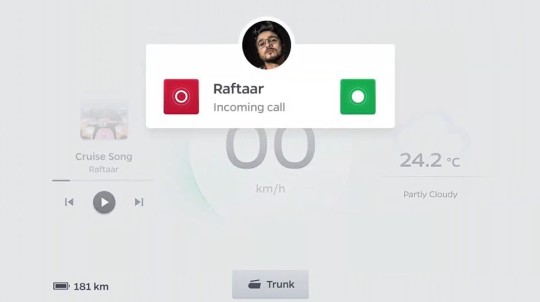
14:17 (IST)
Ola Electric S1 scooter: Display
Here's a look at the Ola S1's 7.0-inch touchscreen, which integrates real-time traffic updates and turn-by-turn navigation. Owners can also schedule a 'home' service using the screen.
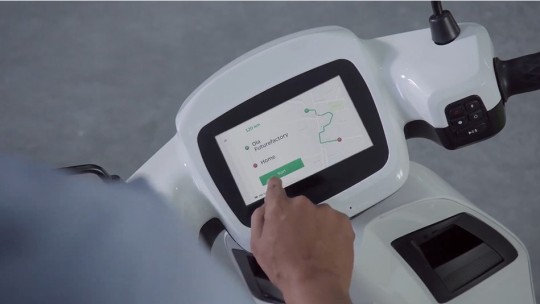
14:15 (IST)
Ola S1 scooter to have four 'moods'
The Ola Electric S1 will have four 'moods', that will change the sound of the scooter - Bolt, Vintage, Care and Wonder.

14:13 (IST)
No key for the Ola electric scooter
Bhavish Aggarwal explains the Ola electric scooter won't have a key at all, with several functions controlled by voice commands.
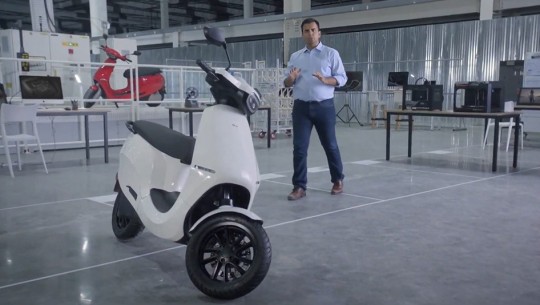
14:13 (IST)
Ola S1 electric scooter performance details
The Ola Electric S1 has a 3.98 kWh lithium-ion battery, a top speed of 115 kph and a 0-60 kph time of just five seconds.
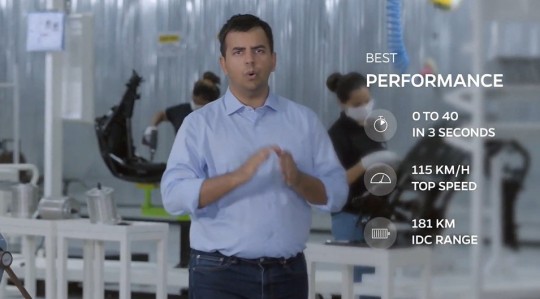
14:09 (IST)
Ola Electric scooter named 'S1'
The Ola Electric scooter is named the S1, and Bhavish Aggarwal says it is 'the best scooter ever built'.
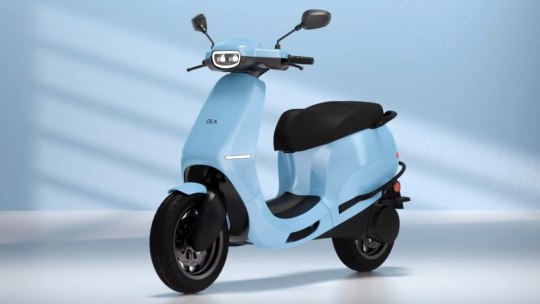
14:06 (IST)
Bhavish Aggarwal gets the Ola Electric scooter launch underway
Ola Electric CEO Bhavish Aggarwal kicks off the Ola Electric scooter launch by highlighting the damage fossil fuels are causing to the environment, and highlights Ola's 'Futurefactory', which will have a production capacity of 10 million units per annum in the future. At full speed, the factory will produce an e-two-wheeler every two seconds.

13:59 (IST)
Ola Electric scooter to be home-delivered
Ola Electric CEO Bhavish Aggarwal confirmed Tech2's newsbreak (dated 21 July) in a tweet on 6 August, stating the company has received bookings for its e-scooter from over 1,000 cities in India, and that it will be delivering the scooters directly to buyers from Day 1. You can read the original story here.
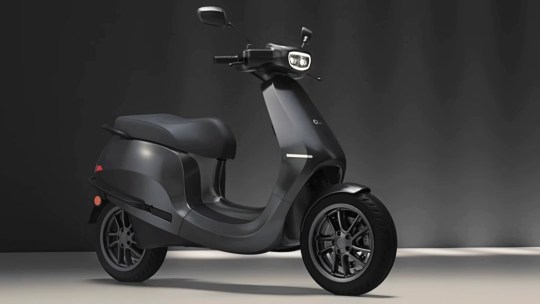
13:51 (IST)
Watch the Ola Electric scooter launch LIVE
You can follow the live stream of the Ola Electric scooter launch right here.
13:40 (IST)
Ola Electric scooter: Expected real-world range of 150 kilometres
Armed with one of the biggest batteries seen on any electric two-wheeler on sale in India till date, the Ola Electric scooter is expected to have a real-world range of around 150 kilometres; something Tech2 revealed in July. You can read all about it here.
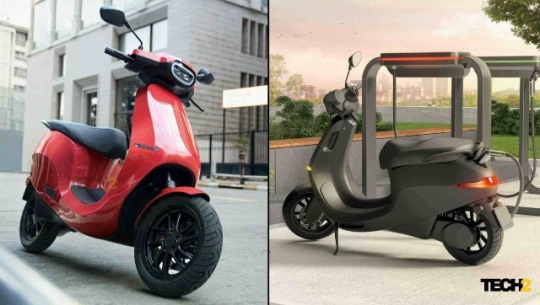
13:25 (IST)
Ola Electric scooter battery details and FAME-II subsidy eligibility
Tech2 has previously reported the top-spec S1 Pro variant of the Ola Electric scooter is likely to have a battery capacity of over 3.6 kWh, but the battery itself will be fixed, and not removable, as seen on the Etergo Appscooter. However, the high capacity lithium-ion battery means the scooter will be eligible for a FAME-II subsidy of well over Rs 50,000, and you can read more about it here.
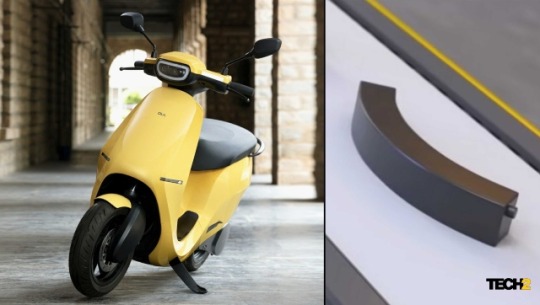
13:14 (IST)
Ola Electric scooter colour options
Ola Electric has previously revealed its maiden electric scooter will be available in a total of ten colours. You can read all about them here.
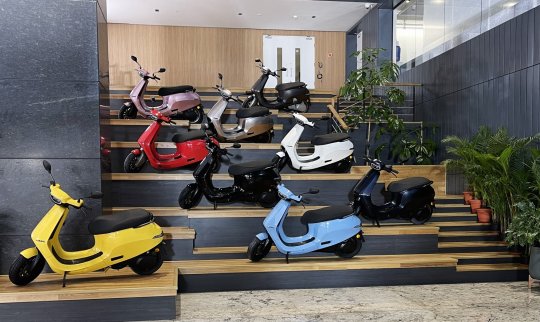
13:07 (IST)
Ola Futurefactory: From then to now
This is what the site of Ola Electric's two-wheeler 'Futurefactory' looked like at the start of this year. Work on the facility began early in February this year, and about six months later, the company is nearly ready to commence mass-production, with the final touches being applied to the plant as you read this.
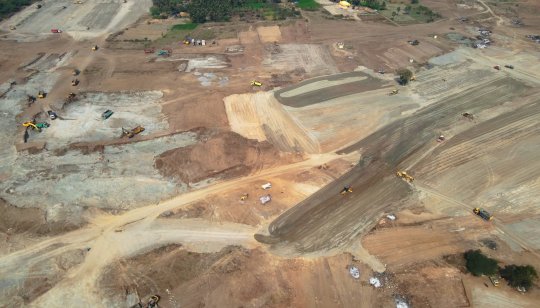
12:57 (IST)
Ola Electric scooter: The origins
If you're wondering, no, Ola has never been a vehicle manufacturer, but it decided to step into the electric mobility space and acquired Dutch start-up Etergo in 2020. It's Etergo's 'Appscooter' (pictured here) that the Ola electric scooter is based on, but while it looks largely identical in terms of design, it has a few key differences, which we shall get to in just a bit...
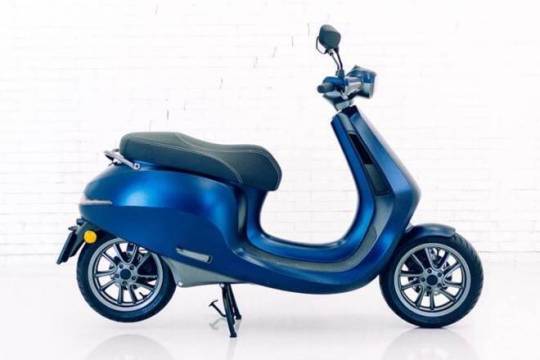
12:50 (IST)
Welcome to Tech2's live blog for the Ola electric scooter launch!
In just about an hour from now, Ola Electric will reveal all about its maiden electric scooter, including its specifications, prices and delivery timelines. We know many of you have been eagerly awaiting this one, so stay with us as we bring you all the updates straight from the launch event!

The day is finally upon us - Ola Electric is all set to launch its maiden electric scooter for India on the country's 75th Independence Day, marking its entry into a fast-evolving two-wheeler market. Over the last few months, Ola Electric has promised its scooter will deliver on performance, range and features, but will still be priced competitively, especially compared to other electric two-wheelers on sale today, and in just a while from now, we're about to find out how much the Ola electric scooter will cost, when will deliveries commence as well as its full specifications and features.
The Ola Electric scooter has the same banana-shaped batteries as seen on the Etergo Appscooter it’s based on; only here, they are fixed, and not removable. Tech2 has previously reported the top-spec Ola e-scooter – expected to be named the Ola S1 Pro – will have a battery capacity of close to 3.6 kWh; among the highest capacities for any electric two-wheeler on sale in India today, which would qualify it for a FAME-II incentive of more than Rs 50,000.
Given the Ola’s real-world range is likely to be as high as 150 kilometres, its ARAI-certified range figure would be higher still, expected to be somewhere between 180-190 kilometres. A lower-spec model – with a different battery configuration and markedly lower range – is also expected to be offered for cost-conscious buyers.
Ola Electric declared its electric scooter will have class-leading acceleration. It’s unclear at this time which scooters Ola considers to be its rivals, but for perspective, the Ather 450X – which is currently the quickest-accelerating e-scooter on sale in India – does 0-40 kph in 3.3 seconds and 0-60 kph in 6.5 seconds. The lower-spec Ather 450 Plus, on the other hand, can do 0-40 kph in 3.9 seconds and 0-60 kph in 8.29 seconds.
The Ola Electric Series S e-scooter also claims to have the largest under-seat storage in its category, with the ability to accommodate two half-face helmets. It will also have a side-stand cut-off function, a virtual switch to unlock the seat incorporated into the large colour instruments display and an e-SIM for connectivity features. It will be available in a total of ten colour options.
Ola’s electric scooter has a single-sided telescopic front suspension and horizontally mounted rear shock absorber, as well as slotted front and rear disc brakes. The pillion foot pegs fold flush into the scooter’s bodywork, and at the back, the Ola electric scooter gets a chunky pillion grab handle and a clear-lens tail-light.
Ola Electric will have fixed charging stations (including slow- and fast-charging points) in 100 cities across India at the time of the Series S’ launch, and will eventually cover more than 400 cities. Its decision to sell directly to buyers online and deliver the scooter to their homes (first reported by Tech2) also means it can retail and service its e-scooter in practically every city in India right from day one.
source https://www.firstpost.com/tech/auto-tech/ola-electric-scooter-launch-live-updates-range-of-up-to-181-kilometres-top-speed-of-115-kph-and-class-leading-acceleration-9888101.html
0 notes
Text
Auto Expo 2020: Electric Cars on Focus as India Chase Green Revolution
Prime Minister Narendra Modi's government wants all new cars on India's roads to be electric by 2030 to combat smog that routinely eclipses dangerous levels in the nation of 1.25 billion.
Electric cars are at the center of attention at India's flagship auto show, where an ambitious plan to phase out intoxicating pollutants causes manufacturers to compete to attract millions of new drivers to their green vehicles. Prime Minister Narendra Modi's government wants all new cars on India's roads to be electric by 2030 to combat the smog that usually overshadows dangerous levels in the nation of 1.25 billion people.
Auto Expo 2020 tickets
Some car giants at the New Delhi motor show have expressed reservations about the aggressive deployment, when so little of India is equipped to charge electric cars and most drivers can not afford the high prices. But few are willing to risk a golden opportunity in the fifth largest car market in the world, where owning a four-wheeled vehicle is a status symbol.
We firmly believe in electricity, and with a leap of faith, we started investing even before the announcement of the government, "said Mahesh Babu, CEO of Mahindra Electric, currently the only company that produces electric vehicles in India." Pioneer in electronic mobility ", invested $ 75 million in its electric fleet since 2010 with another $ 90 million to increase production in the next three years, said Babu.
Others are competing to produce competitive models at lower prices, with Maruti Suzuki, the largest passenger car manufacturer in India, which promises to launch an electric car in Auto Expo 2020. As part of the large sales, Maruti has invested $ 180 million in a new plant to build lithium. -ion batteries in partnership with Japan Denso and Toshiba.
Tata Motors, part of the growing tea-to-steel conglomerate, in September won a contract to supply 10,000 electric cars for the government. The cars, priced at almost $ 15,500, are the government's first attempt to replace its fleet of half a million diesel and gasoline drinkers with electric vehicles.
Tata Motors is also experimenting with electric buses, and is looking to renovate its popular small Nano model as a battery-powered vehicle. Car ownership is steadily increasing in Asia's third largest economy, where four million new cars were sold in 2016. PriceWaterhouseCoopers expects annual sales to increase to almost seven million by 2022.
But most of the money still runs on gasoline and diesel, worsening already atrocious air quality in a country that is among the most polluted in the world. A government report in May said that mobility of passengers through shared and electric vehicles can reduce India's energy demand by 64 percent and carbon emissions by 37 percent by Auto Expo 2020. India is not alone in wanting all-electric cars (Britain and France hope to achieve this by 2040), but New Delhi wants to go faster than others. But the transition has been slow, and some global automotive giants hesitate to take the step in India.
Mercedes described the 2030 deadline as a hurry, while Elon Musk postponed the release in India of its Tesla Model 3. The California-based company is scheduled to open a factory in China, India's regional rival where the car market Electricity is booming.
At the auto show in New Delhi, automakers pointed out that India lacked the charging points needed to refuel exhausted batteries, a major obstacle to making electric cars across the country.
"Who will develop this, who will fund this?" All this is not clear at this time, it is absolutely a crystal ball, "said Manohar Bhat of South Korean giant Kia Motors, which is expected to soon discover an electric vehicle exclusively for the Indian . market.
Other suppliers at the car show said that getting enough lithium to build batteries for millions of electric vehicles would be a challenge and expensive. Mahesh Bendre, an automotive analyst at Karvi Stock Broking, said electric cars would only succeed in India if the price was right.
"The government can push it to a certain point, but in the end it will be reduced to making the right product available to consumers at the right price," he told AFP.
All-electric cars are expected to make up 12 percent of the global market by 2025, according to Bank of America Merrill Lynch analysts last year. But that participation is expected to reach a third by Auto Expo 2020 and by 90 percent by mid-century.
Bhat, from Kia, said that different markets would turn electric when the time was right.
"I would not say we've missed the bus," he said.
0 notes